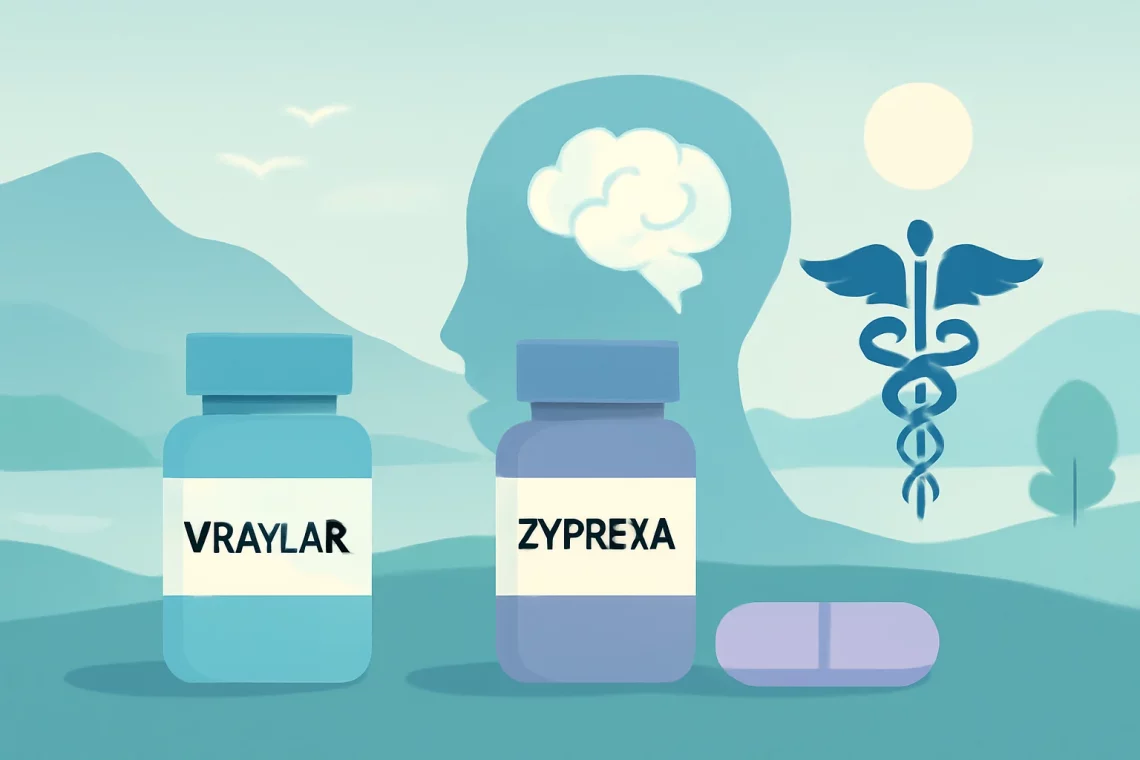-
Metformin vs Rybelsus: Which Diabetes Treatment is Right for You?
Metformin and Rybelsus are two medications frequently discussed in the realm of diabetes management, each with its unique characteristics and benefits. Understanding the differences, benefits, and mechanisms of action of these drugs is crucial for patients, healthcare providers, and anyone interested in diabetes care. As diabetes continues to be a prevalent health concern worldwide, effective management strategies are essential for improving patients’ quality of life and preventing complications associated with the disease. Metformin has long been regarded as a first-line treatment for type 2 diabetes, with a well-established safety and efficacy profile. It primarily works by improving insulin sensitivity and decreasing liver glucose production, thereby helping to regulate blood sugar…
-
Vraylar vs Zyprexa: A Comprehensive Comparison of Two Antipsychotics
Mental health issues have become increasingly prevalent in today’s society, prompting a growing need for effective treatment options. Among the various medications available for managing conditions such as schizophrenia and bipolar disorder, Vraylar and Zyprexa stand out as popular choices. These medications belong to a class known as atypical antipsychotics, which are designed to address the symptoms often associated with these mental health disorders. Understanding the differences between Vraylar and Zyprexa is crucial for patients, caregivers, and healthcare professionals alike. Each medication has its unique mechanism of action, side effects, and efficacy profiles, making it essential to evaluate them carefully in the context of individual patient needs. In this discussion,…
-
Lyrica vs Neurontin: Choosing the Right Treatment for Nerve Pain
Lyrica and Neurontin are two medications commonly used to treat nerve pain and other neurological conditions. While they are often mentioned in conjunction with each other, these drugs have distinct properties and uses. Both medications belong to a class known as anticonvulsants, but they have different mechanisms of action, side effects, and indications. Understanding these differences is crucial for patients and healthcare providers alike, as it can help optimize treatment strategies for various conditions, including neuropathic pain, fibromyalgia, and seizures. The growing prevalence of chronic pain and neurological disorders has led to an increased demand for effective pain management options. Patients are increasingly seeking alternatives to traditional pain relievers, prompting…
-
Meloxicam vs Indomethacin: Which Anti-Inflammatory is Better?
Meloxicam and indomethacin are both nonsteroidal anti-inflammatory drugs (NSAIDs) commonly used to relieve pain, reduce inflammation, and enhance mobility in individuals suffering from various conditions such as arthritis, osteoarthritis, and other musculoskeletal disorders. They belong to a class of medications known for their effectiveness in treating pain and inflammation by inhibiting specific enzymes that contribute to the production of inflammatory substances in the body. While both medications are effective in managing symptoms, they possess distinct characteristics, mechanisms of action, and potential side effects that can influence a healthcare provider’s choice in prescribing them. Understanding the differences and similarities between meloxicam and indomethacin is crucial for patients and healthcare professionals alike.…
-
Tramadol vs Hydrocodone: Key Differences and Similarities Explained
The use of prescription medications for pain management has become increasingly common in recent years. Among these medications, Tramadol and Hydrocodone are two widely prescribed options that serve as effective analgesics. Both drugs belong to the class of opioids, but they have different mechanisms of action, side effects, and potential for addiction. As pain management continues to evolve, understanding the differences and similarities between these two medications is crucial for patients, healthcare providers, and caregivers. Tramadol is a synthetic opioid that works by binding to the brain’s pain receptors, while also inhibiting the reuptake of neurotransmitters like serotonin and norepinephrine. This dual mechanism allows Tramadol to provide relief from moderate…
-
Cyclobenzaprine vs Zanaflex: Understanding Their Differences and Uses
Cyclobenzaprine and Zanaflex are two medications commonly prescribed for muscle relaxation and pain relief. As muscle relaxants, they serve to alleviate discomfort associated with muscle spasms and musculoskeletal conditions. While both medications share a similar purpose, their mechanisms of action, side effects, and use cases can differ significantly. Understanding these differences is crucial for both patients and healthcare providers to make informed decisions regarding treatment options. In a landscape where pain management is paramount, the choice between Cyclobenzaprine and Zanaflex can be pivotal in achieving effective relief and improving patients’ quality of life. This article delves into the nuances of these two medications, exploring their distinct characteristics, benefits, and potential…
-
Amoxicillin vs Flagyl: Which Antibiotic Is Right for You?
Amoxicillin and Flagyl are two widely used antibiotics that play crucial roles in treating various bacterial infections. While both medications aim to combat infections, they operate through different mechanisms and target different types of bacteria. Understanding their differences, uses, and side effects can help patients make informed decisions about their treatment options. Amoxicillin belongs to the penicillin class of antibiotics and is commonly prescribed for respiratory infections, urinary tract infections, and skin infections, among others. It works by inhibiting the growth of bacteria, effectively preventing them from multiplying and spreading. On the other hand, Flagyl, or metronidazole, is often used to treat infections caused by anaerobic bacteria and certain parasites.…
-
Naproxen vs Ketoprofen: Comparing Pain Relief Options for Your Needs
Naproxen and ketoprofen are both nonsteroidal anti-inflammatory drugs (NSAIDs) that are commonly used to relieve pain and reduce inflammation. These medications are widely prescribed and can be found over-the-counter, making them accessible to a large population seeking relief from various conditions. Despite their similarities, naproxen and ketoprofen have distinct characteristics that may make one more suitable than the other depending on the specific needs of the patient. Understanding the pharmacological differences, potential side effects, and appropriate usage of these medications is crucial for both healthcare providers and patients. Inflammation and pain can arise from numerous sources, including arthritis, muscle strains, and other musculoskeletal issues. In these instances, choosing the right…
-
Mounjaro vs Ozempic: Which Diabetes Treatment is Right for You?
The rising prevalence of obesity and related health conditions has led to an increased interest in medications that can aid in weight management and diabetes control. Among the various treatments available, Mounjaro and Ozempic have emerged as two prominent options. Both medications belong to a class of drugs known as GLP-1 receptor agonists, which work by mimicking the effects of the incretin hormone in the body. This hormone plays a critical role in glucose metabolism and appetite regulation. As healthcare professionals and patients alike seek effective solutions, understanding the differences and similarities between Mounjaro and Ozempic becomes essential. These medications not only help in managing blood sugar levels for individuals…
-
Ibuprofen vs Motrin: Understanding Their Differences and Uses
Ibuprofen and Motrin are two widely recognized names in the realm of pain relief and anti-inflammatory medications. Both are often used to alleviate discomfort associated with various conditions, including headaches, muscle aches, arthritis, and even menstrual cramps. Their popularity stems from their effectiveness and the ease of accessibility in pharmacies and over-the-counter settings. Despite their common usage, many people may be unaware of the subtle distinctions between ibuprofen and Motrin. While they are often thought to be interchangeable, understanding their differences and similarities can be crucial for choosing the right medication for specific needs. The active ingredient in both ibuprofen and Motrin is the same, but the branding, formulations, and…







































